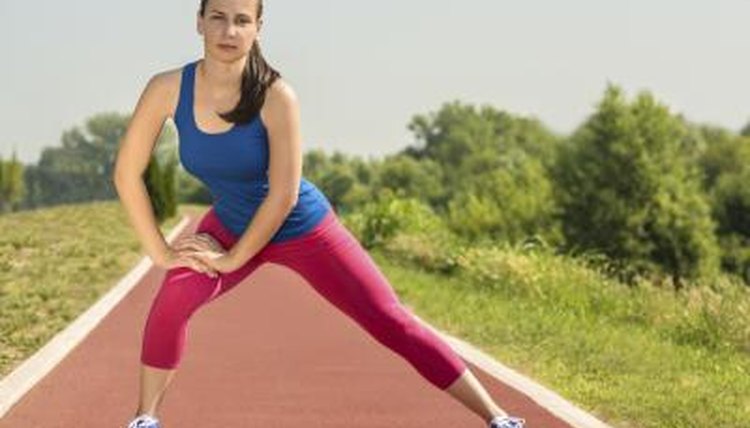Does Stretching Make You Run Faster?

Runners were historically taught that the more you stretch, the better you will perform. An online article titled Running Economy III: Training Techniques to Improve Economy by Ross Tucker, Ph.D., states that human understanding of the relationship between stretching and fast running is currently evolving. Tucker explains that moderate amounts and certain types of stretching, when performed at the appropriate time in relation to running workouts, may make you a faster runner.
Stretching Definitions
Static stretching is the process of lengthening and holding a muscle in that lengthened position for a period of time. For example, when you bend over, touch your toes and hold that position, you are statically stretching your low back as well as the backs of your legs. Running Times magazine reports that dynamic stretching is muscle lengthening achieved through the speed and momentum of movement. A walking lunge is an exercise that dynamically stretches the hips and legs through movement. Yoga is an exercise that engages multiple systems of the body and that includes efforts of both static and dynamic stretching.
Static Stretching and Running Speed
Scientific research currently contraindicates static stretching immediately before a running workout or race, according to Effects of Static Stretching for Thirty Seconds and Dynamic Stretching on Leg Extension Power by Taichi Yamaguchi and Kojiro Ishii, as well as, Effects of Static Stretching on Energy Cost and Running Endurance Performance by Jacob M. Wilson and colleagues. Both studies, published in the Journal of Strength and Conditioning Research show that runners that stretch before workouts run slower than when they perform the same workouts with no prior stretching. Static stretching, if performed after or totally separate from a running workout, is still recommended.
Dynamic Stretching and Running Speed
As the scientific community has learned about the deleterious effects of static stretching on running and other athletic performance, dynamic stretching has emerged as a pre-workout stretching option. Dynamic stretching involves continuous movement of your limbs through their full range of motion. This type of stretching promotes blood flow and warms up the muscles. Dynamic stretching before an endurance or sprint workout or race can improve your running performance and speed.
Yoga and Running Speed
Tucker states that too much muscle flexibility can hinder running performance because very pliable muscles have to do more work to maintain the level of contraction needed for running. Thus, too much yoga may make you a slower runner. However, Tucker and the Yoga Journal both indicate that moderate amounts of yoga, or other means of extended efforts of combined static and dynamic stretching, may create the baseline amount of muscle flexibility and strength needed for high-level running performances.
Conclusion
Current understanding about the relationship between stretching and fast running is evolving. The scientific community recommends dynamic stretching immediately before a running workout or race for faster running, as well as moderate amounts of stretching performed outside of the running workout to create the muscle pliability needed for fast running.
References
- Journal of Strength and Conditioning Research; Effects of Static Stretching for Thirty Seconds and Dynamic Stretching on Leg Extension Power
- Journal of Strength and Conditioning Research; Effects of Static Stretching on Energy Cost and Running Endurance Performance
- Yoga Journal: Yoga for Runners
- Behm DG, Blazevich AJ, Kay AD, McHugh M. Acute effects of muscle stretching on physical performance, range of motion, and injury incidence in healthy active individuals: a systematic review. Applied Physiology, Nutrition, and Metabolism. 2016. 41 (1); 1-11.
- Haddad M, Dridi A, Chtara M, Chaouachi A, Wong DP, Behm D, Chamari K. Static Stretching Can Impair Explosive Performance for At Least 24 Hours. The Journal of Strength & Conditioning Research. 2014.
- Page P. Current concepts in muscle stretching for exercise and rehabilitation. International Journal of Sports Physical Therapy. 2012. 7:109-119.
Writer Bio
Meghan Hicks is an outdoor educator and running coach who began writing in 2009. She is a contributor to the iRunFar website, among others. She holds a Master of Science in resource interpretation from Stephen F. Austin State University and a Bachelor of Science in geology from Beloit College.
